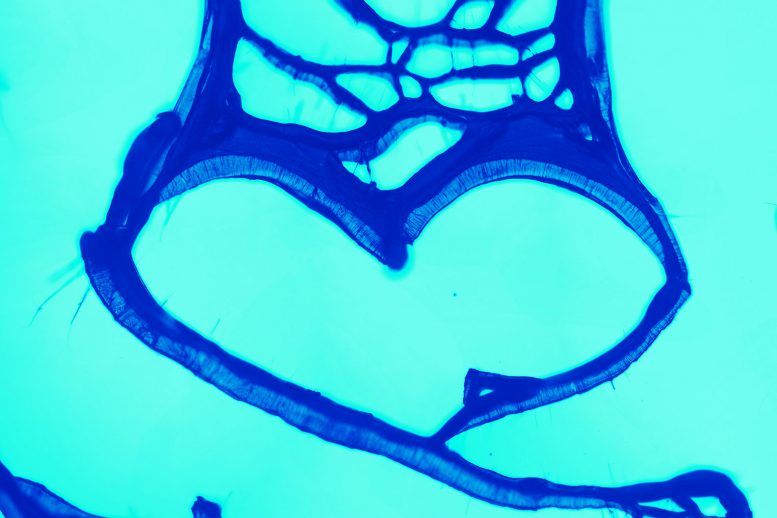
A recolored optical image obtained by MIT researchers shows a heart-shaped carbon nanotube cell. A version of the image is featured on the cover of the February 14 print edition of Physical Chemistry Chemical Physics. Image: Ashley Kaiser and Itai Stein/MIT
Integrating nanoscale fibers such as carbon nanotubes (CNTs) into commercial applications, from coatings for aircraft wings to heat sinks for mobile computing, requires them to be produced on a large scale and at a low cost. Chemical vapor deposition (CVD) is a promising approach to manufacturing CNTs in the needed scales, but it produces CNTs that are too sparse and compliant for most applications.
Applying and evaporating a few drops of a liquid such as acetone to the CNTs is an easy, cost-effective method to more tightly pack them together and increase their stiffness, but until now, there was no way to forecast the geometry of these CNT cells.
MIT researchers have now developed a systematic method to predict the two-dimensional patterns CNT arrays form after they are packed together, or densified, by evaporating drops of either acetone or ethanol. CNT cell size and wall stiffness grow proportionally with cell height, they report in the February 14 issue of Physical Chemistry Chemical Physics.
One way to think of this CNT behavior is to imagine how entangled fibers such as wet hair or spaghetti collectively reinforce each other. The larger this entangled region is, the higher its resistance to bending will be. Similarly, longer CNTs can better reinforce one another in a cell wall. The researchers also find that CNT binding strength to the base on which they are produced, in this case, silicon, makes an important contribution to predicting the cellular patterns that these CNTs will form.
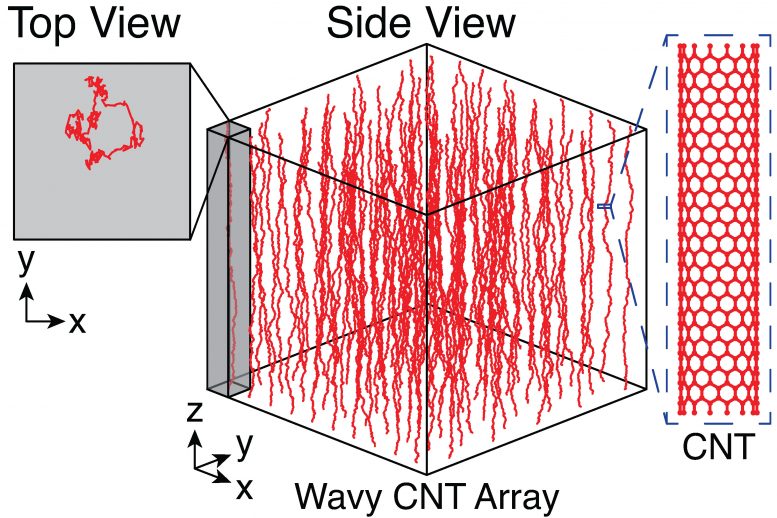
Aligned carbon nanotubes (CNTs) grown by chemical vapor deposition are typically wavy, as seen in side view at the center of the illustration, rather than straight, as illustrated in a single nanotube at the right. They also settle into somewhat random patterns, as shown in the box at the upper left. Waviness reduces the stiffness of CNT arrays by up to 100,000 times, but their stiffness can be increased by densifying, or compressing, the nanotube clusters from two different directions. Image: Itai Stein/MIT
“These findings are directly applicable to industry because when you use CVD, you get nanotubes that have curvature, randomness, and are wavy, and there is a great need for a method that can easily mitigate these defects without breaking the bank,” says Itai Stein SM ’13, Ph.D. ’16, who is a postdoc in the Department of Aeronautics and Astronautics. Co-authors include materials science and engineering graduate student Ashley Kaiser, mechanical engineering postdoc Kehang Cui, and senior author Brian Wardle, professor of aeronautics and astronautics.
“From our previous work on aligned carbon nanotubes and their composites, we learned that more tightly packing the CNTs is a highly effective way to engineer their properties,” says Wardle. “The challenging part is to develop a facile way of doing this at scales that are relevant to commercial aircraft (hundreds of meters), and the predictive capabilities that we developed here are a large step in that direction.”
Detailed measurements
Carbon nanotubes are highly desirable because of their thermal, electrical, and mechanical properties, which are directionally dependent. Earlier work in Wardle’s lab demonstrated that waviness reduces the stiffness of CNT arrays by as little as 100 times, and up to 100,000 times. The technical term for this stiffness, or ability to bend without breaking, is elastic modulus. Carbon nanotubes are from 1,000 to 10,000 times longer than they are thick, so they deform principally along their length.
For an earlier paper published in the journal Applied Physics Letters, Stein and colleagues used nanoindentation techniques to measure the stiffness of aligned carbon nanotube arrays and found their stiffness to be 1/1,000 to 1/10,000 times less than the theoretical stiffness of individual carbon nanotubes. Stein, Wardle, and former visiting MIT graduate student Hülya Cebeci also developed a theoretical model explaining changes at different packing densities of the nanofibers.
The new work shows that CNTs compacted by the capillary forces from first wetting them with acetone or ethanol and then evaporating the liquid also produces CNTs that are hundreds to thousands of times less stiff than expected by theoretical values. This capillary effect, known as elastocapillarity, is similar to how a sponge often dries into a more compact shape after being wetted and then dried.
“Our findings all point to the fact that the CNT wall modulus is much lower than the normally assumed value for perfect CNTs because the underlying CNTs are not straight,” says Stein. “Our calculations show that the CNT wall is at least two orders of magnitude less stiff than we expect for straight CNTs, so we can conclude that the CNTs must be wavy.”
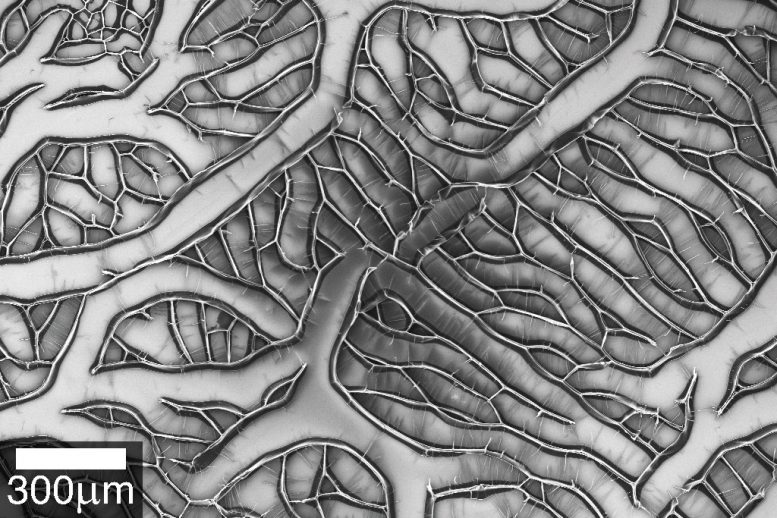
A scanning electron microscope image shows that heat-treated aligned carbon nanotubes self-assemble into cells with clearly defined cell walls when they are densified by applying and evaporating a few drops of liquid acetone or ethanol. MIT researchers have developed a systematic method to predict the geometry of the two-dimensional cellular patterns that these nanotubes will form. Bright lines represent top edges of cell walls, while darker portions represent nanotubes closer to the silicon substrate base, which is seen in the flat spaces between cell walls. Image: Ashley Kaiser/MIT
Heat adds strength
The researchers used a heating technique to increase the adhesion of their original, undensified CNT arrays to their silicon wafer substrate. CNTs densified after heat treatment were about four times harder to separate from the silicon base than untreated CNTs. Kaiser and Stein, who share first authorship of the paper, are currently developing an analytical model to describe this phenomenon and tune the adhesion force, which would further enable the prediction and control of such structures.
“Many applications of vertically aligned carbon nanotubes [VACNTs], such as electrical interconnects, require much denser arrays of nanotubes than what is typically obtained for as-grown VACNTs synthesized by chemical vapor deposition,” says Mostafa Bedewy, assistant professor at the University of Pittsburgh, who was not involved in this work. “Hence, methods for post-growth densification, such as those based on leveraging elastocapillarity have previously been shown to create interesting densified CNT structures. However, there is still a need for a better quantitative understanding of the factors that govern cell formation in densified large-area arrays of VACNTs. The new study by the authors contributes to addressing this need by providing experimental results, coupled with modeling insights, correlating parameters such as VACNT height and VACNT-substrate adhesion to the resulting cellular morphology after densification.
“There are still remaining questions about how the spatial variation of CNT density, tortuosity [twist], and diameter distribution across the VACNT height affects the capillary densification process, especially since vertical gradients of these features can be different when comparing two VACNT arrays having different heights,” says Bedewy. “Further work incorporating spatial mapping of internal VACNT morphology would be illuminating, although it will be challenging as it requires combining a suite of characterization techniques.”
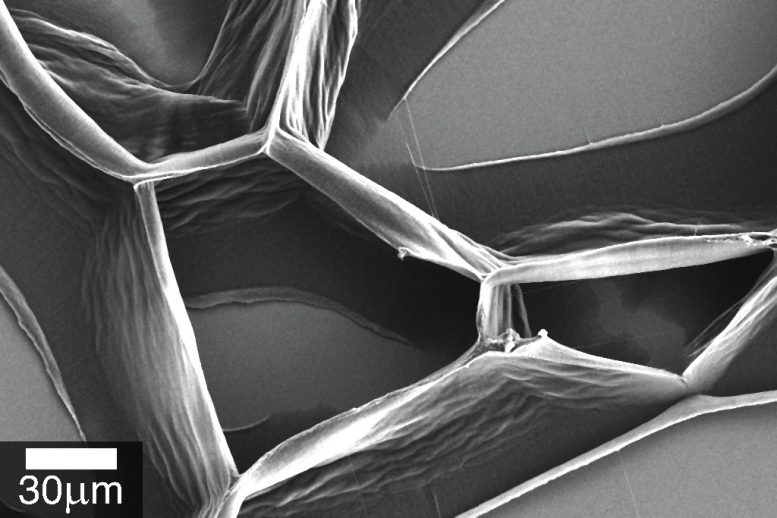
(Detail of previous image.) MIT researchers report that CNT cell size and wall stiffness grow proportionally with cell height. Image: Ashley Kaiser/MIT
Picturesque patterns
Kaiser, who was a 2016 MIT Summer Scholar, analyzed the densified CNT arrays with scanning electron microscopy (SEM) in the MIT Materials Research Laboratory’s NSF-MRSEC-supported Shared Experimental Facilities. While gently applying liquid to the CNT arrays in this study caused them to densify into predictable cells, vigorously immersing the CNTs in liquid imparts much stronger forces to them, forming randomly shaped CNT networks. “When we first started exploring densification methods, I found that this forceful technique densified our CNT arrays into highly unpredictable and interesting patterns,” says Kaiser. “As seen optically and via SEM, these patterns often resembled animals, faces, and even a heart — it was a bit like searching for shapes in the clouds.” A colorized version of her optical image showing a CNT heart is featured on the cover of the February 14 print edition of Physical Chemistry Chemical Physics.
“I think there is an underlying beauty in this nanofiber self-assembly and densification process, in addition to its practical applications,” Kaiser adds. “The CNTs densify so easily and quickly into patterns after simply being wet by a liquid. Being able to accurately quantify this behavior is exciting, as it may enable the design and manufacture of scalable nanomaterials.”
This work made use of the MIT Materials Research Laboratory Shared Experimental Facilities, which are supported in part by the MRSEC Program of the National Science Foundation, and MIT Microsystems Technology Laboratories. This research was supported in part by Airbus, ANSYS, Embraer, Lockheed Martin, Saab AB, Saertex, and Toho Tenax through MIT’s Nano-Engineered Composite Aerospace Structures Consortium and by NASA through the Institute for Ultra-Strong Composites by Computational Design.
Reference: “Process-morphology scaling relations quantify self-organization in capillary densified nanofiber arrays” by Ashley L. Kaiser, Itai Y. Stein, Kehang Cui and Brian L. Wardle, 2 January 2018, Physical Chemistry Chemical Physics.
DOI: 10.1039/C7CP06869G

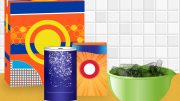
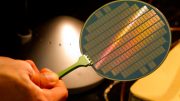
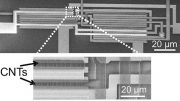
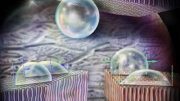
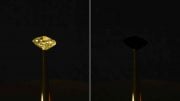
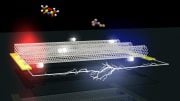
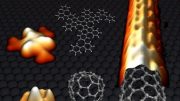
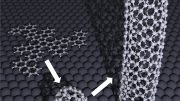
Be the first to comment on "Creating Predictable Patterns from Unpredictable Carbon Nanotubes"